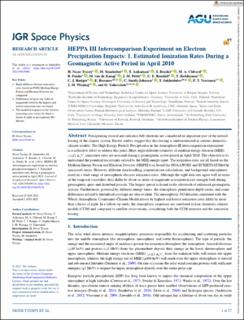| dc.contributor.author | Tyssøy, Hilde Nesse | |
| dc.contributor.author | Sinnhuber, M. | |
| dc.contributor.author | Asikainen, T. | |
| dc.contributor.author | Bender, Stefan | |
| dc.contributor.author | Clilverd, M.A. | |
| dc.contributor.author | Funke, B. | |
| dc.contributor.author | van de Kamp, M. | |
| dc.contributor.author | Pettit, J.M. | |
| dc.contributor.author | Randall, C.E. | |
| dc.contributor.author | Reddmann, T. | |
| dc.contributor.author | Rodger, C.J. | |
| dc.contributor.author | Rozanov, E. | |
| dc.contributor.author | Smith-Johnsen, Christine | |
| dc.contributor.author | Sukhodolov, T. | |
| dc.contributor.author | Verronen, P.T. | |
| dc.contributor.author | Wissing, J.M. | |
| dc.contributor.author | Yakovchuk, O. | |
| dc.date.accessioned | 2023-01-11T14:58:31Z | |
| dc.date.available | 2023-01-11T14:58:31Z | |
| dc.date.created | 2022-04-28T14:21:39Z | |
| dc.date.issued | 2022 | |
| dc.identifier.issn | 2169-9380 | |
| dc.identifier.uri | https://hdl.handle.net/11250/3042771 | |
| dc.description.abstract | Precipitating auroral and radiation belt electrons are considered an important part of the natural forcing of the climate system. Recent studies suggest that this forcing is underestimated in current chemistryclimate models. The High Energy Particle Precipitation in the Atmosphere III intercomparison experiment is a collective effort to address this point. Here, eight different estimates of medium energy electron (MEE) (>30 keV) ionization rates are assessed during a geomagnetic active period in April 2010. The objective is to understand the potential uncertainty related to the MEE energy input. The ionization rates are all based on the Medium Energy Proton and Electron Detector (MEPED) on board the NOAA/POES and EUMETSAT/MetOp spacecraft series. However, different data handling, ionization rate calculations, and background atmospheres result in a wide range of mesospheric electron ionization rates. Although the eight data sets agree well in terms of the temporal variability, they differ by about an order of magnitude in ionization rate strength both during geomagnetic quiet and disturbed periods. The largest spread is found in the aftermath of enhanced geomagnetic activity. Furthermore, governed by different energy limits, the atmospheric penetration depth varies, and some differences related to latitudinal coverage are also evident. The mesospheric NO densities simulated with the Whole Atmospheric Community Climate Model driven by highest and lowest ionization rates differ by more than a factor of eight. In a follow-up study, the atmospheric responses are simulated in four chemistry-climate models (CCM) and compared to satellite observations, considering both the CCM structure and the ionization forcing. | en_US |
| dc.language.iso | eng | en_US |
| dc.publisher | American Geophysical Union | en_US |
| dc.rights | Attribution-NonCommercial-NoDerivatives 4.0 Internasjonal | * |
| dc.rights.uri | http://creativecommons.org/licenses/by-nc-nd/4.0/deed.no | * |
| dc.title | HEPPA III Intercomparison Experiment on Electron Precipitation Impacts: 1. Estimated Ionization Rates During a Geomagnetic Active Period in April 2010 | en_US |
| dc.type | Journal article | en_US |
| dc.type | Peer reviewed | en_US |
| dc.description.version | publishedVersion | en_US |
| dc.rights.holder | Copyright 2021 the authors | en_US |
| dc.source.articlenumber | e2021JA029128 | en_US |
| cristin.ispublished | true | |
| cristin.fulltext | original | |
| cristin.qualitycode | 2 | |
| dc.identifier.doi | 10.1029/2021JA029128 | |
| dc.identifier.cristin | 2019839 | |
| dc.source.journal | Journal of Geophysical Research (JGR): Space Physics | en_US |
| dc.relation.project | Norges forskningsråd: 302040 | en_US |
| dc.relation.project | Norges forskningsråd: 223252 | en_US |
| dc.identifier.citation | Journal of Geophysical Research (JGR): Space Physics. 2022, 127 (1), e2021JA029128. | en_US |
| dc.source.volume | 127 | en_US |
| dc.source.issue | 1 | en_US |

